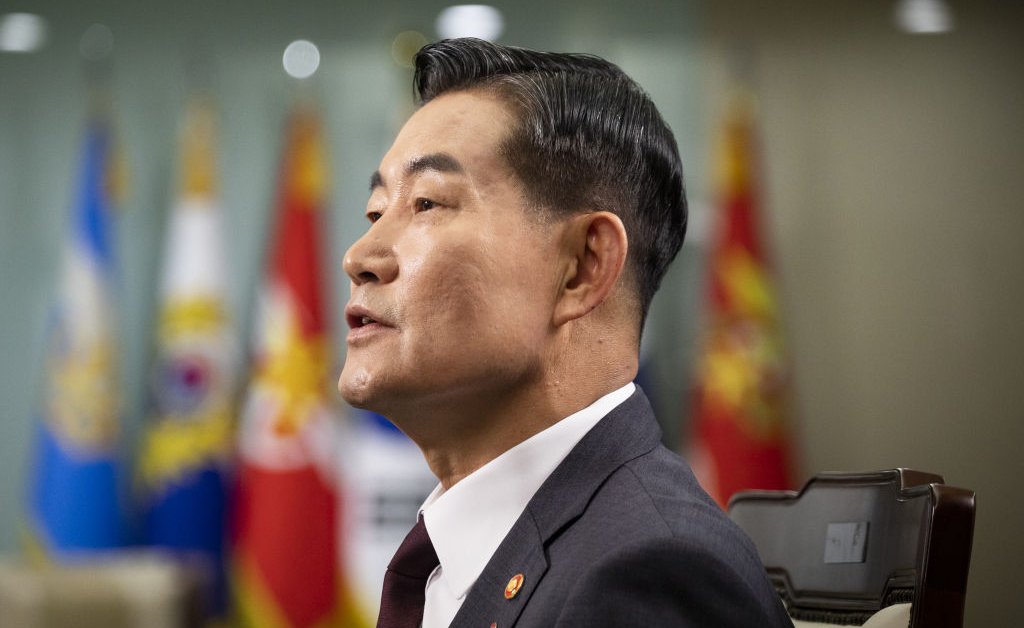North Korea has sent containers to Russia that could hold nearly 5 million artillery shells and Russian President Vladimir Putin will likely seek even more when he soon visits Pyongyang, South Korea’s defense minister said.
Shin Wonsik said in an interview with Bloomberg News that Seoul has detected at least 10,000 shipping containers being sent from North Korea to Russia, which could hold as many as 4.8 million artillery shells of the likes that Putin has used in his bombardment of Ukraine.
“Putin is expected to seek closer security cooperation with North Korea, especially military supplies such as artillery shells that are necessary to seize a chance to win,” Shin said. He also said North Korea has sent dozens of ballistic missiles to help Putin’s attack on his neighbor.
In return for the munitions, Russia has sent to North Korea technology to help in its plans to deploy an array of spy satellites as well as conventional arms such as tanks and aircraft.
Putin is set to visit North Korea as early as next week, the DongA Ilbo newspaper of South Korea has reported. The trip would be his first there since July 2000 and it’s set to stoke concerns from the U.S. and its partners of arms transfers that have helped the Kremlin in its assault on Ukraine in exchange for aid propping up Kim Jong Un’s regime.
With Kyiv now taking delivery of billions of dollars in fresh arms from its U.S. and European partners, the window for a Russian breakthrough is narrowing even as it continues to fire missiles and drones at Ukrainian cities including energy infrastructure.
The munitions sent by North Korea since Putin and Kim met in Russia in September for a meeting that led to stepped up trade between the neighbors have likely far outstripped what has been sent by the U.S. and the European Union. It has allowed the Kremlin’s forces to bombard Ukraine, as it was forced to ration ammunition due to dwindling supplies — with aid being held up in the U.S. Congress.
Read More: Why Kim Jong Un’s Russia Trip Is a Sign of Putin’s Weakness
While Ukrainian officials raised the alarm about the threat of a Russian breakthrough during months of delays over U.S. arms deliveries, Kyiv’s troops mostly held the line despite being outgunned as much as 10-1 by Moscow’s invading army. The European Union has pledged to send Ukraine one million artillery shells by the end of the year.
Kim, meanwhile, has been spending heavily on his missile program. Missile tests last year cost about $1 billion according to Shin. The figure represents about 4% of North Korea’s economy, which South Korea’s central bank estimated to be about $24.5 billion in 2022.
“North Korea is ignoring its people’s hardships to carry out missile provocations,” Shin said. “The money is enough to cover North Korea’s food shortages for a year.”
A retired three-star Army general, Shin was a lawmaker of the ruling People Power Party until he assumed the ministerial job in October. He has been one of the most outspoken South Korean officials on North Korea’s cooperation with Russia and the threats it poses to the global security.
Satellite imagery indicates that Pyongyang is making preparations for a Putin visit, the Seoul-based specialist service 38 North reported. Images show construction in Kim Il Sung Square in central Pyongyang indicative of the preparation for a military parade and planes parked at Pyongyang’s main airport have been moved at the tarmac, likely to ready the facility for Putin, it reported Tuesday.
While Russia and North Korea have denied the arms transfers, commercial satellite imagery and intelligence provided by the U.S. government shows Russian cargo ships regularly shuttling between the once sleepy North Korean port of Najin near the border of Russia. Most have been bound for Dunay, a former Soviet submarine base about 180 kilometers (110 miles) away.
The White House has provided imagery it said showed weapons being sent on the route and delivered by rail thousands of miles away to a depot in the Russian town of Tikhoretsk for use in Ukraine.




